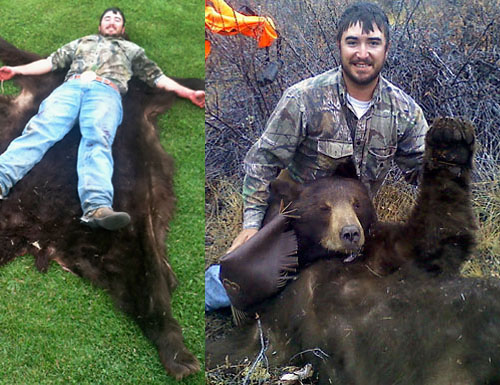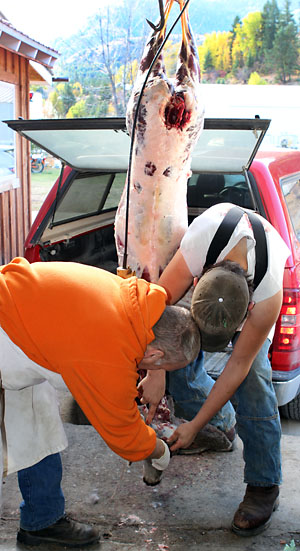home | internet service | web design | business directory | bulletin board | advertise | events calendar | contact | weather | cams

 Jimmy Barnhart of Carlton with the 600-pound bear he shot near his home and showing the size of the hide. Photos by permission of Jimmy Barnhart Jimmy Barnhart of Carlton with the 600-pound bear he shot near his home and showing the size of the hide. Photos by permission of Jimmy Barnhart
Numbers Down, Success Up When hunter Jimmy Barnhart set out on horseback from his house up Texas Creek on Sunday morning, Oct. 14, he was scouting for deer. Then, about 10:30 a.m., he saw a big black bear up behind his house. “It looked like it was getting ready to take a nap,” Barnhart, 27, told Grist. He figured the animal had been feeding off the neighbor’s apple trees. “It was about 100 yards away. I shot once, and he went 20 or 30 feet and dropped,” Barnhart said. But he didn’t realize just how big the animal was until it was time to move it. That required a tractor. The bear weighed roughly 600 pounds, said Seth Thomson, who works with his dad, Chris, during this hectic time of year at Thomson's Custom Meats in Twisp. The meat locker was filled with carcasses, including Barnhart’s big bear, as general deer hunting drew to a close Oct. 21. Barnhart’s bear stood 6 feet 6 inches tall, according to Seth. Because the bear didn’t have much fat on him, Seth said he thinks it may have been 25 years old. Most of the bears brought in for processing by hunters weigh about 150 pounds, he added, but this year they’ve been running around 300 pounds.  Twisp police chief Paul Budrow, left, assists Justin Dunlap with a doe shot by David Chistensen of Winthrop at the busy Thomson's Custom Meats. Photo by Solveig Torvik Twisp police chief Paul Budrow, left, assists Justin Dunlap with a doe shot by David Chistensen of Winthrop at the busy Thomson's Custom Meats. Photo by Solveig Torvik
Barnhart said he intends to have the skull measured because the animal is so big it may be a state record. Bear hunting season, which began Aug. 15, ends Nov. 15. Since deer hunting season opened for bow hunters Sept. 1, at least 250 deer carcasses have been brought into the Thomson’s butchering facility, said Chris, who added that while fewer hunters may have showed up this season, those he’s dealt with seem to have had a very good success rate. “Last year it was the worst in 20 years,” he said. “Participation is down a little bit this year,” said the Washington Department of Fish and Wildlife’s Okanogan district wildlife biologist, Scott Fitkin. But he said he expects the final tallies of deer taken county-wide to be about average nonetheless. Indications from WDFW field agents are that not as many hunters came to the Methow as might have been expected. The campgrounds were not as full, he said, adding that it’s hard to say if the economy, weather, gas prices or the fires contributed to fewer numbers. Over a typical hunting season, an estimated 6,000 hunters are active in the valley, said Fitkin. The WDFW doesn’t break out figures just for the Methow Valley, he added, but it belongs to the Western division of the county’s hunting area, which is everything west of the Okanogan River. Three-fourths of the hunting activity takes place in that division, he explained, and two-thirds of that is in the Methow. This means that “maybe half” of the 2,500 deer typically taken countywide are from the Methow, according to Fitkin’s calculations. “If we have 6,000 to 7,000 people coming to the Methow, it’s pretty significant,” he added. Even though the general modern firearms deer season ended half an hour after sunset on Oct. 21, a few lucky hunters who drew permits for so-called “quality hunts” still have a chance to bag a deer until Nov. 20. These late-season permits are coveted because it’s easier to locate the animals, said Fitkin. On Game Management Unit 224 northeast of Winthrop - which includes Bear Creek, Pearrygin Creek and Ramsey Creek - 15 permits have been issued for any mule deer buck and 15 for any white tail buck, said Fitkin. In addition, archery permits are in effect for bow hunters on Game Management Unit 239 in the southeastern portion of the valley until Nov. 30. 10/21/2012 Comments
|